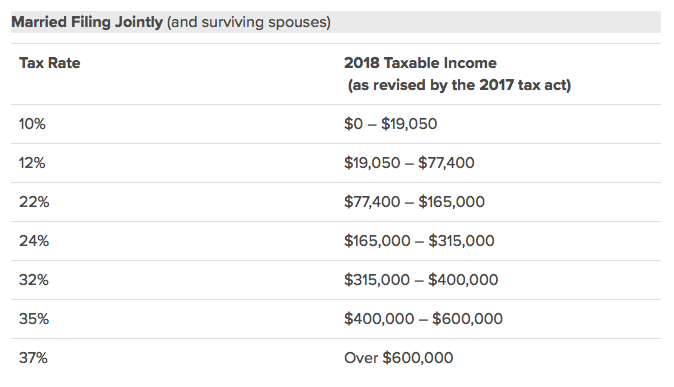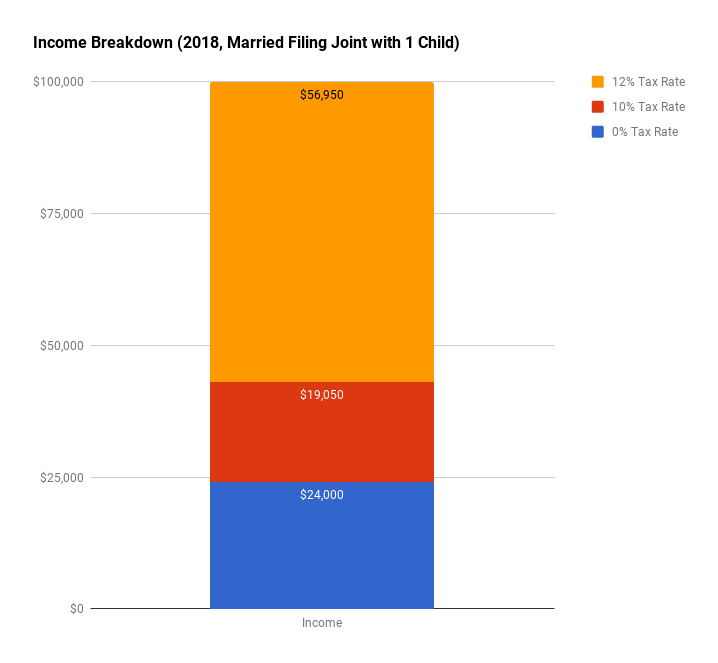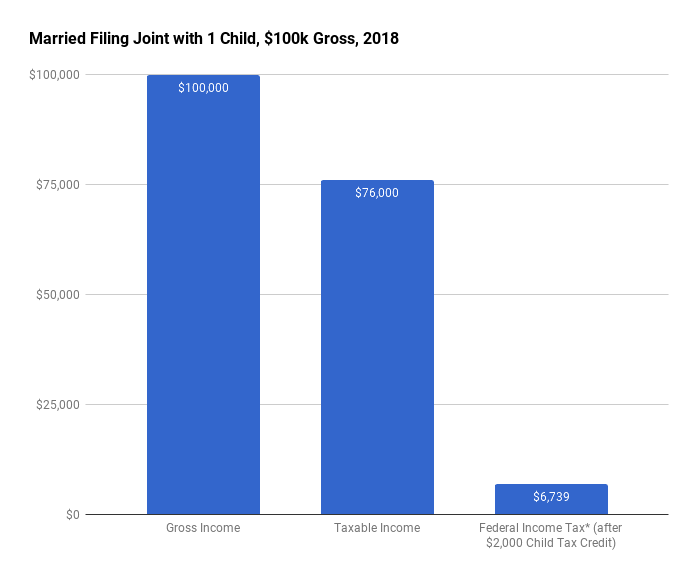 The Tax Cuts and Jobs Act (TCJA) changed up the personal income tax brackets, exemptions, and deductions. Here is an updated graphical breakdown of a simple scenario for a married filing joint couple with 1 dependent in Tax Year 2018. I’ll also try to illustrate the relationship between gross income, taxable income, marginal tax rate, and effective tax rates. In future posts, I will also run 2018 examples for single filers and married joint filers without kids.
The Tax Cuts and Jobs Act (TCJA) changed up the personal income tax brackets, exemptions, and deductions. Here is an updated graphical breakdown of a simple scenario for a married filing joint couple with 1 dependent in Tax Year 2018. I’ll also try to illustrate the relationship between gross income, taxable income, marginal tax rate, and effective tax rates. In future posts, I will also run 2018 examples for single filers and married joint filers without kids.
2018 federal income tax rates for married joint filers. Taken from the official IRS tax tables (source):

The following changes also apply for Tax Year 2018:
- The personal exemption deduction is now gone ($0), from $4,050 in 2017.
- The standard deduction for single taxpayers and married taxpayers filing separately rises to $12,000 from $6,350.
- The standard deduction for married taxpayers filing joint returns rises to $24,000 from $12,700.
- The standard deduction for heads of household rises to $18,000 from $9,350.
- The Child Tax Credit was expanded with higher income phaseout limits and is now worth up to $2,000 per qualifying child.
Let’s say your household combined gross income is $100,000 a year. You are a married couple with one child 16 or under, and both earn $50,000 gross income. You are both employees that receive W-2 income only (i.e. neither are self-employed). You don’t have any additional income sources like interest, capital gains, rents, etc. You don’t have any deductions like IRA/401k contributions or mortgage interest that will allow you to itemize deductions. We will ignore any state or local income taxes.
Gross income. Let’s start with your annual $100,000 gross household income. There are no personal exemptions for you and your dependents any more. You do get the larger standard deduction which is $24,000 for married filing joint in 2018. Since you don’t have a lot of itemized deductions, you fall back onto the standard deduction.

The first 24,000 of your gross income is not taxable. Without doing anything special at all, your $100,000 in gross income is now only $76,000 in taxable income after personal exemptions and the standard deductions.
The first $19,050 of taxable income is subject to a 10% tax rate. Shave off 10% of $19,050 and put that on your tax bill ($1,905). The remaining $56,950 of taxable income is moved onto the next tax bracket.
The next $58,350 in taxable income is subject to a 12% tax rate. However, we only have $56,950 left. So we shave off 12% of $56,950 ($6,834) and add that to the existing $1,905. The total tax bill is now $8,739.
In this example, this 12% is your marginal tax bracket. If you earned another $1, it would be taxed at this marginal rate of 12%. Even with a six-figure income, a married couple can still land in the 12% marginal tax bracket (pre-tax 401k or IRA contributions would reduce taxable income even more).
Federal Child Tax Credit. As this income doesn’t exceed the phaseout limits and your child is 16 or under, you also get the full $2,000 Child Tax Credit. A tax credit lowers your tax bill dollar-for-dollar as opposed to a deduction that only lowers your taxable income. Thus, your tax bill is reduced from $8,739 to $6,739. (If you had additional children, each one would reduce your tax bill by another $2,000. Note that there is a limit to the refund-ability of the credit if it makes your tax bill negative.)

Payroll taxes. These aren’t technically federal income taxes, but you must each pay a Social Security tax (OASDI) of 6.2% and Medicare payroll tax (HI) of 1.45% of your gross income. That’s $3,100 a year for Social Security and $725 a year for Medicare. You both earn $50,000 gross and don’t exceed the income caps. (Your respective employers pay the same amount.)
Overall effective tax rate. You paid $6,739 in federal income taxes on $100,000 of gross income, for an overall effective tax rate of 6.74%. Again, you also paid 7.65% in payroll taxes. Your average tax rate is lower than a couple without kids due to the child tax credit. In this case, having a kid reduced your tax bill by $2,000.
The same married couple with one child in 2017 would have paid $9,340 in federal income taxes on $100,000 of gross income, for an overall effective tax rate of 9.34%.
 The Best Credit Card Bonus Offers – 2025
The Best Credit Card Bonus Offers – 2025 Big List of Free Stocks from Brokerage Apps
Big List of Free Stocks from Brokerage Apps Best Interest Rates on Cash - 2025
Best Interest Rates on Cash - 2025 Free Credit Scores x 3 + Free Credit Monitoring
Free Credit Scores x 3 + Free Credit Monitoring Best No Fee 0% APR Balance Transfer Offers
Best No Fee 0% APR Balance Transfer Offers Little-Known Cellular Data Plans That Can Save Big Money
Little-Known Cellular Data Plans That Can Save Big Money How To Haggle Your Cable or Direct TV Bill
How To Haggle Your Cable or Direct TV Bill Big List of Free Consumer Data Reports (Credit, Rent, Work)
Big List of Free Consumer Data Reports (Credit, Rent, Work)
Awesome illustration and explanation. Thank you.
Can you do a similar one for married couple with 2 kids?
I thought he made it clear enough in the example above, but since basic math seems to be beyond many people in the computer age…
Married couple with 2 kids in the example above pays $4,739 in tax, for a 4.74% overall effective tax rate (just subtract $2,000 for the second kid).
Thanks. For a married couple with two kids, I believe your tax bill would just go down another $2,000 due to another Child Tax Credit. The overall tax bracket diagram would look the same.
The Target program is cancelled (I tried it on my phone)
I have found myself referring to this post multiple times in the last few months. It’s much easier to read and understand vs the IRS site for sure. (not much of a compliment, I know :p) Anyway, thanks for the clear explanation!
Thanks!
Hi Jonathan, That is a nice way to lay this out…easy to follow. This year took me by surprise as I have 5 kids so it seems I gained $12k on the std deduction..but lost $24k on the exemptions… ( 1 kid is now Married). This new tax environment doesn’t seem to help me at all as I’m losing $12k..maybe only $11k since I have 1 kid under 16.. Thoughts?